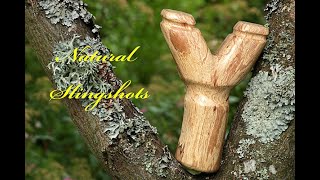Natural slingshots – finding suitable beechwood forks in the woods
Natural slingshots – finding suitable beechwood forks in the woods
 Finding suitable natural beechwood forks to make slingshots – a general overview of the subject, including initial making steps.
Finding suitable natural beechwood forks to make slingshots – a general overview of the subject, including initial making steps.
Before you venture all excited into the woods to harvest natural forks, make sure you’re wearing long trousers, hiking boots, and have efficient bug spray against mosquitos and ticks, as both enjoy the shady foliage like you do, particularly during the warmer season: tick bites are not necessarily harmless by any account, avoid if possible.
You will need an efficient branch cutting saw to get through thicker sections of wood fairly rapidly: your trunk space is doubtlessly limited. Ideal locations are those where hardwood trees have been felled: the longer ago this is, the better, because the clutter of deadwood branches on the forest ground will have dried out naturally to a large extent – which of course cuts down the drying and waiting period before you can eagerly start making your naturals (or “natties” as the are frequently referred to). Generally speaking, there is always some residual dampness, even in older wood, and you may need to let it dry out fully: the microwave method is not necessarily a good idea.
You need to check carefully for wood rot and woodworms, as both will weaken the structural strength of the wood grain i.e. the danger of forks suddenly snapping. In any case, you want to make sure that the forks are strong enough for the repeated forces of bands or tubes being drawn repeatedly: the last thing you want are broken sections of fork limbs flying back into your face. Placing the natural forks with the fork tips already cut to the desired height between vise clamps, and pushing hard against the grip section will tell you whether the wood is safe or not. Natural forks with branch knots in the fork section are better discarded.
Thicker fork limbs are always safer than thinner ones, and forks limbs cut shorter rather than longer are safer too. Avoid pinewood and similar woods, as they do not have the grain density and hardness needed to ensure structural strength for slingshots. When using unfamiliar wood types, always read up about the hardness properties first for safety purposes. If in doubt, ask someone who really knows the subject.
As always with such projects, you are fully responsible for the way you interpret the information provided in this video, and I will not be held liable for accidents of any kind. That said, a natural slingshot made with the right kind of hardwood in good condition is probably safe most of the time. In any case, you should always wear safety glasses when shooting slingshots – just in case.
Have fun in making and shooting natural slingshots!